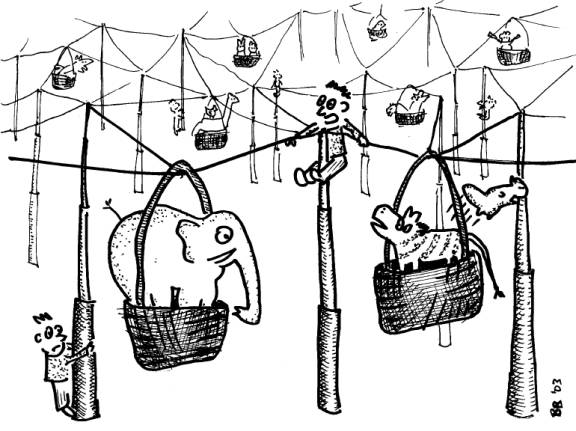A Laypersonís View of the Reasons Behind the
August Power Blackout
August 14, 2003 will go down in
the annals of the electricity industry as the day the lights went out
from Detroit to New York City. The
31 hour blackout affected 50 million people in the US and Canada and was
estimated to have an economic cost of $4-6 billion. (Associated Press
2003) Still, as US economic
disasters go, the 2003 blackout is unlikely to make the Top 10 list,
which includes hurricanes, tornadoes, floods, and others.
While small scale failures of the electricity system are common
and unavoidable, blackouts are less common, and large scale failures
such as this one are fortunately rare.
Nevertheless, the great reliance on the grid by all industries
and communities and the potential for economic and human loss makes any
widespread blackout a real cause for concern.
The exact events that led to
the August 14th blackout are still unclear.
The North American
Electric Reliability Council (NERC), for example, has focused on
a combination of mechanical and human failures.
In time, investigations will most likely pinpoint the specific
sequence of events that led to the massive power outage.
No matter what is determined to have been the direct cause, it is
now necessary to consider how the US electricity grid can be updated,
operated, and utilized in order to provide consumers with a safe,
reliable, and cost efficient electric system.
A Circus Analogy of the Transmission System
Before considering possible
solutions to strains on the electricity system, it is important to
understand how the electrical grid operates.
The grid is a complex interconnected web consisting of
generators, transmission and distribution lines serving industrial and
residential consumers. Keeping
all of these components in balance is a delicate task.

One might visualize the system
as a complicated structure used in a circus balancing act. Rigid poles that can extend up and down represent the power
plants. Ropes represent the
transmission system, and baskets of varying sizes with animals inside
represent electricity demand. The
ropes extend from the tops of the poles to form a complex spider web.
At various points in that web, baskets hang down.
The art of the circus performance is to adjust the ropes and
poles so that each basket hangs just slightly off the ground.
If any one of the baskets touches the ground, or worse, suddenly
falls to the ground, the performance is considered a failure.
Novice performers set the poles
just high enough and the ropes just tight enough to support the baskets.
But challenges exist for those more advanced at the art.
The first challenge is that the loads of the baskets change over
time as animals climb on or off. They
are heaviest on hot summer afternoons when the elephant air conditioners
climb on board. In this situation, more poles are brought out and all are
raised to their fullest. The extra poles and weight also increase the
tension on the ropes, and some may approach the limit of their strength.
Overall, the electricity
jugglers normally provide a pretty good show and fully impress the
audience. However, poles
have been known to break during performances.
As soon as this occurs, the other poles are adjusted to take up
the load and keep the baskets off the ground.
Ropes have been known to unravel midway through the show.
When this happens, the other ropes usually adjust automatically,
and the baskets experience only a slight perturbation
Sometimes, though rarely, a
rope that is critical to the entire success of the act snaps. When that happens, the other ropes may begin to bounce up and
down. Some may fail
entirely under the extra tension in the apparatus.
In this situation, some poles may also be in an immediate danger
of breaking. A performer
may then cut a rope to save a pole.
Rarely, things may be so bad that one basket is cut loose so that
the others can stay up.
When a performance does fail or
the apparatus breaks, the audience might walk away wondering what went
wrong. Some may say there
should have been more poles to support all of the ropes, or that the
poles should have been taller. Others
may think there should have been more ropes or that they should have
been stronger. Still others
may think that the baskets should not have been so heavy.
A good performer will consider all of these factors before the
next event.
In any event, it is clear that
the electricity balancing act can become very complicated and very
chaotic in a matter of seconds. While
that makes a circus act fun to watch, the performers prefer things to go
smoothly. The best
performers have prepared for each situation and know how to tweak each
piece of their apparatus to keep everything in balance no matter what
happens.
David White et al @ Synapse
Energy, August 2003.